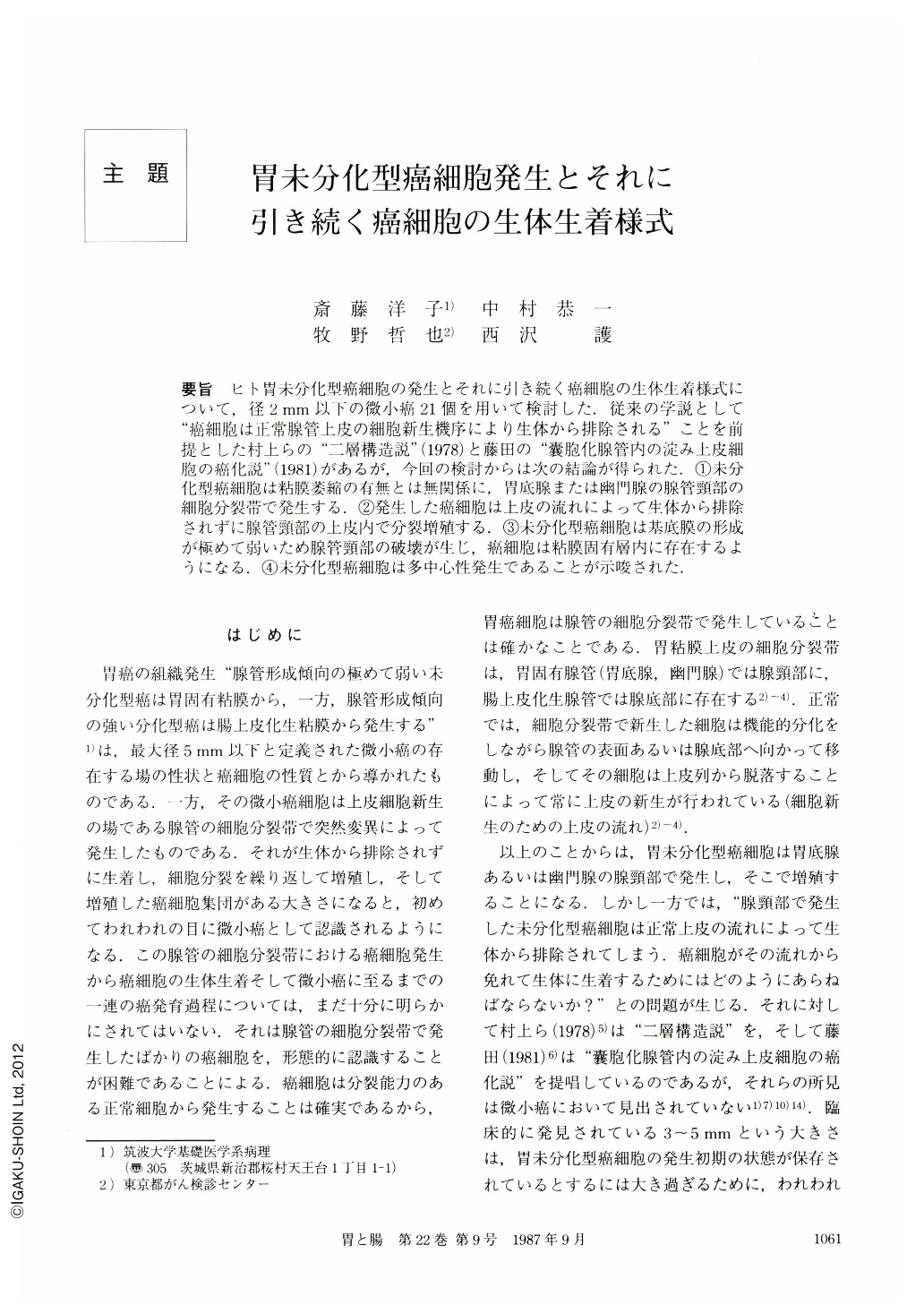Japanese
English
- 有料閲覧
- Abstract 文献概要
- 1ページ目 Look Inside
要旨 ヒト胃未分化型癌細胞の発生とそれに引き続く癌細胞の生体生着様式について,径2mm以下の微小癌21個を用いて検討した.従来の学説として“癌細胞は正常腺管上皮の細胞新生機序により生体から排除される”ことを前提とした村上らの“二層構造説”(1978)と藤田の“囊胞化腺管内の淀み上皮細胞の癌化説”(1981)があるが,今回の検討からは次の結論が得られた.①未分化型癌細胞は粘膜萎縮の有無とは無関係に,胃底腺または幽門腺の腺管頸部の細胞分裂帯で発生する.②発生した癌細胞は上皮の流れによって生体から排除されずに腺管頸部の上皮内で分裂増殖する.③未分化型癌細胞は基底膜の形成が極めて弱いため腺管頸部の破壊が生じ,癌細胞は粘膜固有層内に存在するようになる.④未分化型癌細胞は多中心性発生であることが示唆された.
According to the histogenesis of gastric cancer, cells of undifferentiated carcinoma not forming tubules arise from the neck portion of the fundic and pyloric glands with mutation, because the mitotic zone for cell renewal of the epithelium exists at the neck portion1)~4). However the great majority of the microcarcinomas of undifferentiated type measuring less than 5 mm at their largest diameter, are limited to the lamina propria mucosae without replacing the pre-existing glands1)7)13). Although Murakami, et al (1978)5) and Fujita (1981)6) have proposed respectively “Double layer structure (Fig. 10)” and “Cystic glands including cancer cells (Fig. 11)”, those phenomena have not been found in the microcarcinomas reported in the literatures1)7)10)13). So it must be said that the proliferative mode of undifferentiated carcinoma of the stomach following cancer cell development is something which has not yet been clarified.
The purpose of this study is to elucidate histologically the growth-process of undifferentiated carcinoma arising from the fundic and pyloric glands.
Objects of this study are 21 microcarcinomas of undifferentiated type measuring less than 2 mm at their largest diameter (Fig. 1). Among the 21 microcarcinomas, seven foci measured less than 1 mm at their largest diameter, and the remaining 14 measured 1.1 to 2.0 mm. Serial sections of the microcarcinomas were made.
Among the 21 microcarcinomas, 14 foci were located in the fundic gland mucosa and the remaining seven in the pyloric gland mucosa (Table 1). All the 14 microcarcinomas in the fundic gland mucosa and four out of the seven ones in the pyloric gland mucosa were limited to the lamina propria mucosae superficial to the neck portion of the glands (Table 3, Fig. 3). Only three microcarcinomas in the pyloric gland mucosa occupied the full thickness of the lamina propria mucosae. The microcarcinomas were very tiny, and the great majority of those cancer cells proliferated in the lamina propria mucosae, without replacing the pre-existing glandular epithelium. In only one microcarcinoma were several neck portions of the glands observed to have been replaced by cancer cells (Fig. 9). Moreover, several ghost glands where cancer cells had conglomerated like a gland were observed in three microcarcinomas (Fig. 8). It is not clear if those are the neck portions replaced completely by cancer cells, because the undifferentiated cancer cells sometimes take the form of small glands.
The mucosae adjacent to the microcarcinomas were essentially normal in 12 out of 21 foci (57%) (Fig. 3) and were atrophic in the remaining nine foci (43%) (Table 2).
With regard to the underlying proper glands of the microcarcinomas, 12 out of the 14 microcarcinomas located in the fundic gland mucosa were well preserved, and only two foci were atrophic as compared with the fundic glands of the adjacent mucosa. Meanwhile, in the seven microcarcinomas located in the pyloric gland mucosa, the underlying pyloric glands of six foci showed atrophy (Table 4, Fig. 5). Those findings may be related to the life span of the gastric proper glands, because the Iife span of the fundic gland is 150 to 200 days and that of the pyloric gland is 14 to 20 days2)~4).
In the superficial one-third of mucosae harboring the microcarcinomas, the number of the glands including the neck portion decreased in comparison with that of the adjacent mucosae (Fig. 3, Table 5). That decrease may be attributable to destruction of the neck portion of the gland by cancer cell proliferation, because the life span of the mucous cells constituting the gastric foveolae is as short as two to three days2)~4).
One microcarcinoma measuring approximately 2 mm at its largest diameter was completely divided into three subgroups, and the mucosae among those three were not involved in cancer cell infiltration (Fig. 7). In four microcarcinomas, cancer cells were divided into a few groups according to their density (Fig. 6). It may be suggested that those microcarcinomas had developed from plural neck portions of the glands14).
Based on the findings obtained, the proliferative mode of undifferentiated carcinoma arising from the fundic and pyloric glands following cancer cell development may be concluded to be as follows (Fig. 13): Cancer cells develop in the neck portion of the gastric proper glands by mutation, independently of atrophy of the glands, and proliferate there (Figs. 3 and 9). In consequence of that, the neck portion of the gland is destroyed and replaced by cancer cells (Fig. 4).
They also proliferate in the lamina propria mucosae, because the cancer cells of undifferentiated type show a tendency to be lacking in basement membrane (Table 7, Fig. 12)12). It may be deduced that cancer cells of undifferentiated type develop multifocally from the neck portions of the proper gastric glands.

Copyright © 1987, Igaku-Shoin Ltd. All rights reserved.


